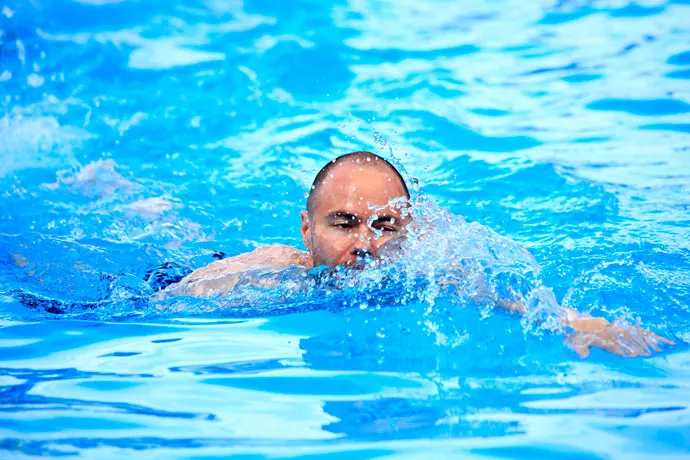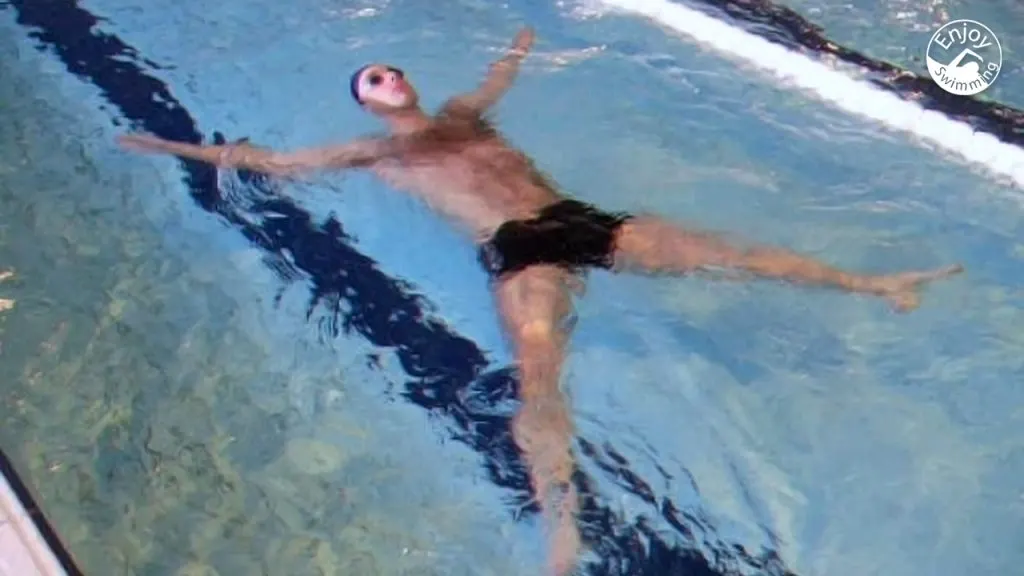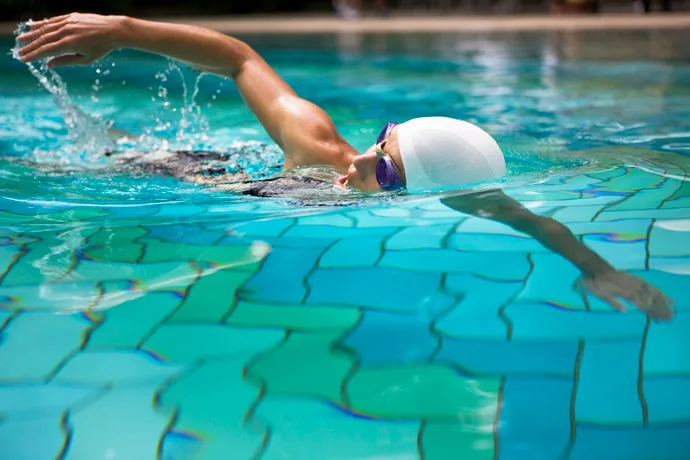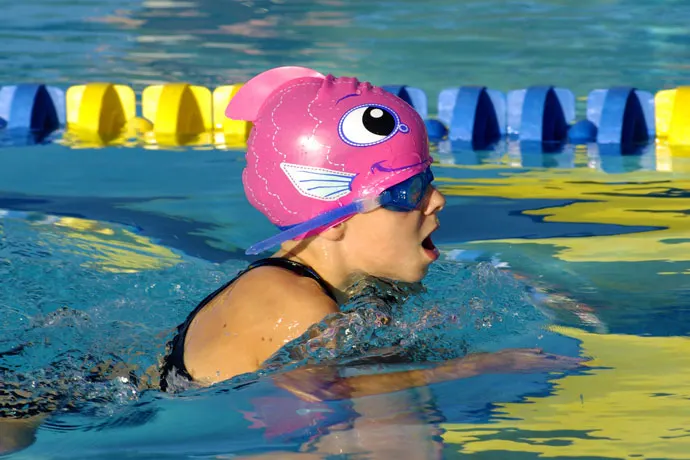You may wonder which basic swimming strokes are easy to learn and make the most sense for beginners. Of course, there are many opinions on this, but below, we have listed the swimming strokes we believe are best for beginning swimmers.
Dog Paddle
The dog paddle is a basic swimming stroke that mimics the way dogs (and other mammals) move in the water.

The arm and leg movements of the dog paddle are pretty simple and, therefore, can be quickly picked up by beginners. In addition, the head is always kept above water, which facilitates breathing and allows the swimmer to keep his eyes open and thus easily orient himself.
On the other hand, you have to move your limbs constantly to keep your head above water, which can be tiring, especially for young children.
In the dog paddle, the body remains in a slightly inclined, prone position throughout the stroke cycle. Therefore, the head is kept above the water, and the face is directed forward.
The arms perform similar alternating movements. First, the hand moves forward in the water from the chest, with the palm facing down, until the arm is fully extended. Then, once the arm is fully extended, the hand is moved downward and backward toward the chest, providing propulsion. From there, a new arm stroke cycle can begin.
In the dog paddle, the legs execute the same kind of alternating flutter kick used in the front crawl. The legs are kicked up and down from the hips, the knees bend slightly, the feet are extended on the downkick, and they are in a more relaxed position on the upkick. These movements are performed quickly and should not be too broad.
Breathing can occur freely, as the head is always kept above water.
Start learning the dog paddle here.
Elementary Backstroke
The elementary backstroke can also be considered one of the basic swimming strokes, as its simple technique can be learned relatively quickly.

The elementary backstroke is swum on the back in a horizontal position. Therefore, the novice swimmer must have some proficiency with floating in this position.
The arm movements in the elementary backstroke are symmetrical and are performed simultaneously. Initially, the arms are at the sides of the body, with the palms facing inward. The arm stroke begins by drawing the hands up along the body to the shoulders.
Once the hands reach the shoulders, the arms are fully extended to the side with the palms facing backward. Next, the still-extended arms are pulled back and inward, creating propulsion, before the arms finally return to the starting position.
The legs also perform simultaneous, symmetrical movements. The leg movements are very similar to those of the breaststroke, except that the swimmer floats on his back and not on his chest.
Initially, the legs are extended and held together. The kick cycle begins when the heels are drawn toward the buttocks. When the knees are bent about 90°, the legs are spread, and the feet are turned outward.
Afterward, the legs are stretched and brought together again, while the feet are also turned inward again. Propulsion is generated in the last phase of the kick. A short glide phase follows the completion of the arm stroke and kick.
The elementary backstroke allows the swimmer to swim in a relatively relaxed and economical manner. Indeed, the arm and leg movements are pretty simple, and a glide phase can be observed at the end of the stroke cycle.
Additionally, the face remains above the water surface the entire time, so breathing is unrestricted. For these reasons, the elementary backstroke is well suited as a basic swimming stroke for beginners.
Start learning elementary backstroke here.
Front Crawl
In their learn-to-swim programs, the U.S., Canada, and Australia primarily emphasize the front crawl as a basic swimming stroke [1].
While the front crawl is not necessarily the easiest stroke to learn, once mastered, it is a good foundation to build on, and learning the other popular swimming strokes should not be a significant hurdle.

The front crawl is swum in a prone position with rotation along the longitudinal axis of the body during the stroke cycle.
The arms perform the same movements alternately. One arm pulls back to the hip in the water from a forward extended position, tracing an S-shaped pattern. The other arm recovers forward, leaving the water at the hip with a bent elbow, moving past the head, and then extending forward in the water. At this point, the arms exchange roles.
The legs perform an alternating flutter kick. They kick up and down from the hips, with the knees bending only slightly and the feet extended during the downkick and relaxed during the upkick. The leg movements should be fast and compact, with the heels barely breaking the surface of the water.
In the front crawl, the head is kept in line with the body. The face is turned downward most of the time, except when breathing. To breathe, the swimmer turns his head to the recovering arm side until the face is above the water.
He then breathes under the recovering arm as it passes his head and subsequently turns his head back down when the arm extends forward. The exhalation occurs continuously while the face is in the water.
The arm and leg movements in the front crawl are rather straightforward and can be learned relatively quickly by beginners. This explains the popularity of the front crawl as a basic swimming stroke in North America and Australia.
On the other hand, learning to breathe is often a bit more challenging. One way to deal with this difficulty is to practice the movements of the arms and legs separately from the breathing.
For example, the movements of the arms and legs can be practiced with a swimming snorkel, which allows for unrestricted breathing. On a similar note, breathing can be practiced without arm movements in our balance and rotation drills for the front crawl.
Start learning front crawl here.
Breaststroke
The breaststroke is the first swimming stroke taught to beginners in many parts of Europe, Asia, and Japan [1]. This is because it allows a beginner to keep his head above water, which facilitates his breathing, vision, and orientation.
Consequently, breaststroke is well-suited as a basic swimming stroke, even though the movements of the arms and legs are somewhat more complex than in the front crawl.

Breaststroke is performed in the prone position. The body rotates along its transverse axis, lying completely flat in the water at the end of the glide phase and then assuming a more inclined position at the beginning of the arm recovery when the head and shoulders rise out of the water.
The arm movements are symmetrical and are performed synchronously. First, the arms are extended forward at the end of the glide phase. They then move in a circular movement, first backward and outward, then backward and inward, with the hands meeting below the chest. Finally, the arms are brought forward once more to their starting position.
The leg movements are also symmetrical and performed synchronously. In the beginning, the legs are fully extended and held together. The kick starts by drawing the heels towards the buttocks. Once the knees are bent about 90 degrees, the legs are spread, and the feet are turned outward.
The propulsive phase of the kick follows, where the legs are stretched and initially spread further apart, then brought together before the feet are turned inward again. Finally, a short glide phase ensues where the arms are together and fully extended forward, and the legs are together and fully extended backward.
In the basic variant of the breaststroke, the swimmer can take a slightly inclined position in the water and thus keep his head above the water. This allows for unrestricted breathing, which is a significant advantage for beginners.
Advanced swimmers, on the other hand, move their head in and out of the water during the stroke cycle to reduce drag and increase their speed.
In that case, the head and shoulders rise above the water at the end of the pull phase, as the arms are brought together below the chest. A quick breath is then taken before the arms are stretched forward, and the head and shoulders sink back into the water. Exhalation occurs in the water for the remainder of the stroke cycle.
Start learning breaststroke here.
References
- Langendorfer, Stephen J. (2013) “Which Stroke First?,” International Journal of Aquatic Research and Education: Vol. 7 : No. 4 , Article 2, p. 1. https://doi.org/10.25035/ijare.07.04.02

Riley
Monday 12th of March 2018
I will like to prove people wrong. Puppy paddle is NOT a swimming stroke.
help me
Tuesday 10th of April 2018
Yes it is! It's the only thing I can do cuz I get woozy.
A
Wednesday 1st of March 2017
Listen Grace, you are wrong. My daddy is a swimmer and he knows the rules. -A
Riley
Tuesday 13th of March 2018
I am so on your side. I agree. I bet your dad A is a great swimmer.
I am one too. I am on level 7-8. I am always talked about for being the best swimmer in class and on my team.
I am a boy so it is easy. I don't have to worry about my hair getting in the way.
I am doing a project about swimming. So I need some facts. I could use some help from A and Grace. Crystal does not sound like she has good and useful info.
Listen -A you need to get more info too.
Crystal
Thursday 2nd of April 2015
Fun fact coming from a competitive swimmer: You can literally swim any of the four official swimming styles (fly, back, breast, free/crawl) in a freestyle race without getting disqualified because it is a free style event.
However, since crawl is faster, most people choose to swim that style.
Notice, it never prevented this guy in my club from swimming an 800 free in butterfly, just to prove to everyone that he is insane!
Grace
Thursday 12th of January 2017
No you can not, I am a swimmer in Indiana and these are not the rules.